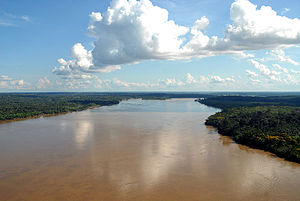Madeira river
| Madeira River | |
|
The river in the outskirts of Porto Velho
|
|
| Name origin: Portuguese, "wood river" | |
| Countries | Bolivia, Brazil |
|---|---|
| Part of | Amazon Basin |
| Tributaries | |
| - left | Beni River |
| - right | Mamoré River, Ji-Paraná River, Dos Marmelos River, Manicoré River, Mataurá River, Mariepauá River, Aripuanã River |
| Cities | Nova Olinda do Norte, Borba, Novo Aripuanã, Manicoré, Humaitá, Porto Velho |
| Source | Confluence of Beni and Mamoré |
| - location | Near Guayaramerín, Bolivia & Brazil |
| - elevation | 180 m (591 ft) |
| - coordinates | 10°38′19″S 65°39′20″W / 10.63861°S 65.65556°W |
| Mouth | Amazon River |
| - location | Amazonas, Brazil |
| - elevation | 40 m (131 ft) |
| - coordinates | 3°22′32″S 58°46′23″W / 3.37556°S 58.77306°WCoordinates: 3°22′32″S 58°46′23″W / 3.37556°S 58.77306°W |
| Length | 3,380 km (2,100 mi) |
| Basin | 850,000 km2 (328,187 sq mi) |
| Discharge | for near mouth |
| - average | 31,200 m3/s (1,101,818 cu ft/s) |
| - max | 52,804 m3/s (1,864,756 cu ft/s) |
| - min | 2,346 m3/s (82,848 cu ft/s) |
|
Map of the Madeira River watershed
|
|
The Madeira River (Portuguese: Rio Madeira, [ˈʁi.u mɐˈdejɾɐ]) is a major waterway in South America, approximately 3,250 km (2,020 mi) long. The Madeira is one of the biggest tributaries of the Amazon, accounting for about 15% of the water in the basin. A map from Emanuel Bowen in 1747, held by the David Rumsey Map Collection, refers to the Madeira by the pre-colonial, indigenous name Cuyari:
The River of Cuyari, called by the Portuguese Madeira or the Wood River, is formed by two great rivers, which join near its mouth. It was by this River, that the Nation of Topinambes passed into the River Amazon.
The mean inter-annual precipitations on the great basins vary from 75 to 300 centimetres (2.46–9.84 ft), the entire upper Madeira basin receiving 170.5 centimetres (5.59 ft). The greatest extremes of rainfall are between 49 to 700 centimetres (1.61–22.97 ft). At its head, the Madeira on its own is still one of the largest rivers of the world, with a mean inter-annual discharge of 18,000 cubic metres per second (640,000 cu ft/s), i.e. 536 cubic kilometres (129 cu mi) per year, approximately half the discharge of the Congo River. The mean inter-annual contribution of the Bolivian Andes is 4,170 cubic metres per second (147,000 cu ft/s), i.e. 132 cubic kilometres (32 cu mi) per year, representing 25% of the discharge of the entire upper Madeira basin. On the further course towards the Amazon, the mean discharge of the Madeira increases up to 31,200 cubic metres per second (1,100,000 cu ft/s).
Between Guajará-Mirim and the falls of Teotônio, the Madeira receives the drainage of the north-eastern slopes of the Andes from Santa Cruz de la Sierra to Cuzco, the whole of the south-western slope of Brazilian Mato Grosso and the northern slope of the Chiquitos sierras. In total, the catchment area is 850,000 km2, almost equal in area to France and Spain combined. The waters flow into the Madeira from many large rivers, the principal of which, (from east to west), are the Guaporé or Itenez, the Baures and Blanco, the Itonama or San Miguel, the Mamoré, Beni, and Mayutata or Madre de Dios, all of which are reinforced by numerous secondary but powerful affluents. The climate of the upper catchment area varies from humid in the western edge with the origin of the river's main stem by volume (Río Madre de Dios, Río Beni) to semi arid in the southernmost part with the andine headwaters of the main stem by length (Río Caine, Río Rocha, Río Grande, Mamoré).
...
Wikipedia


